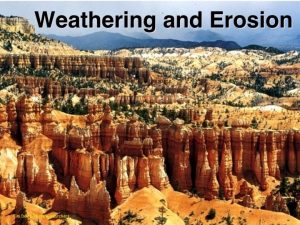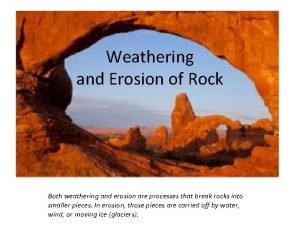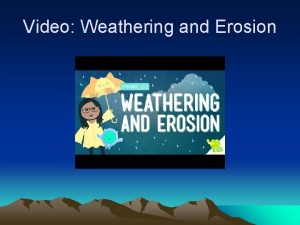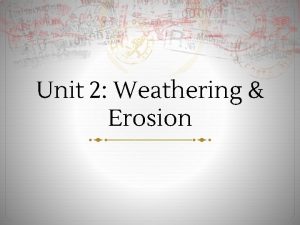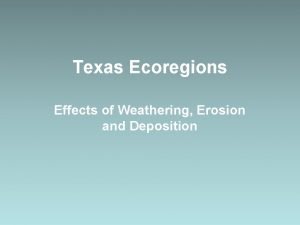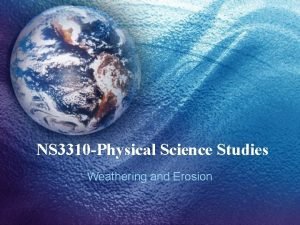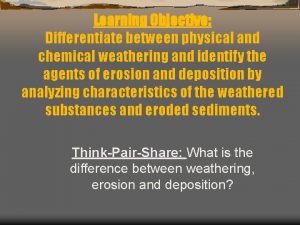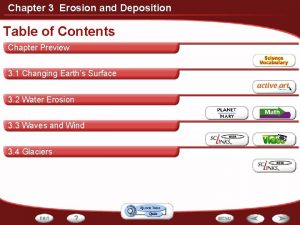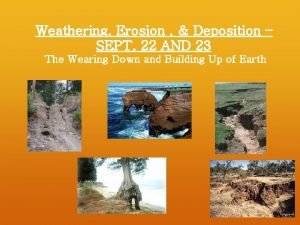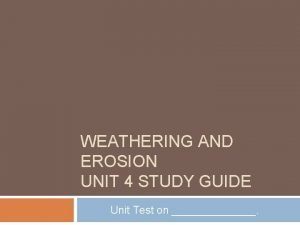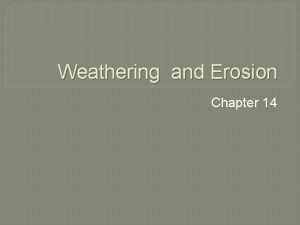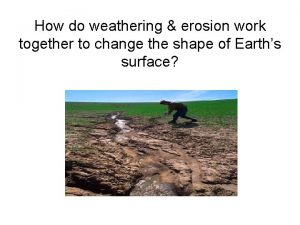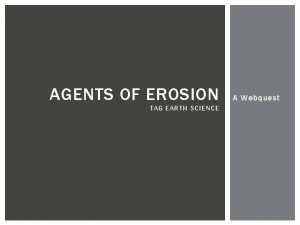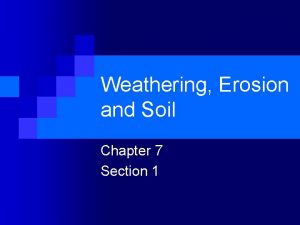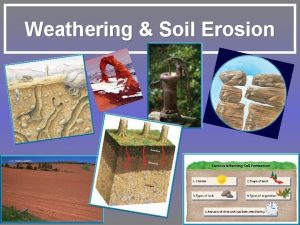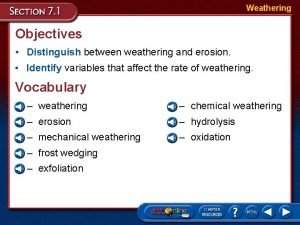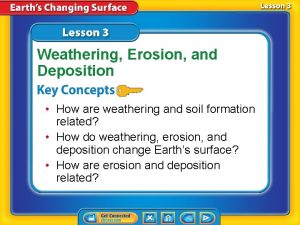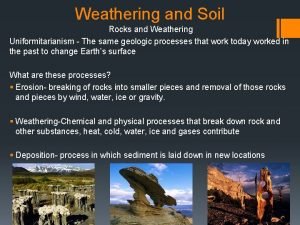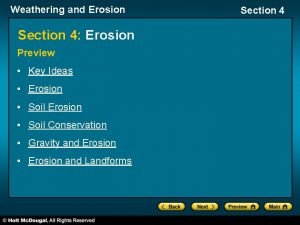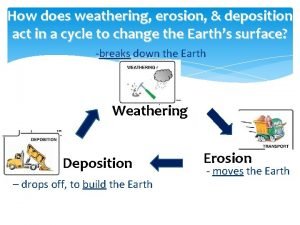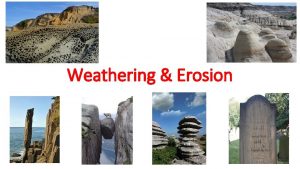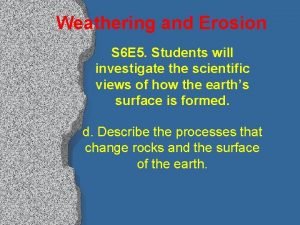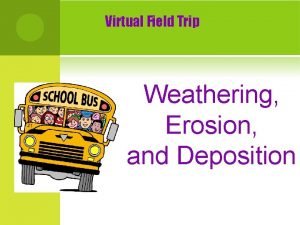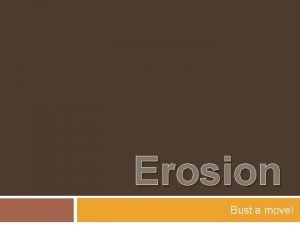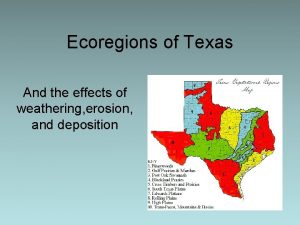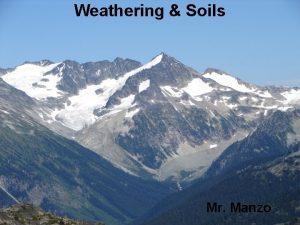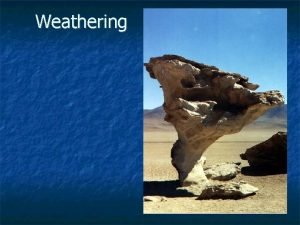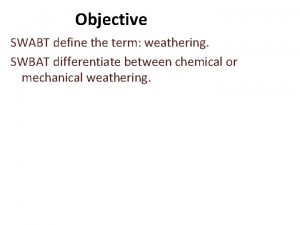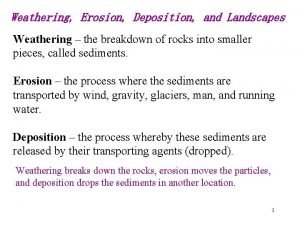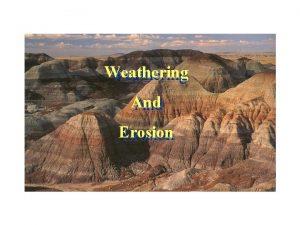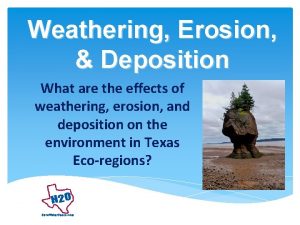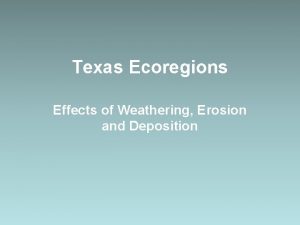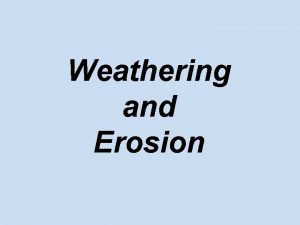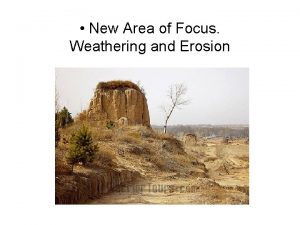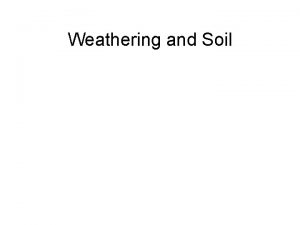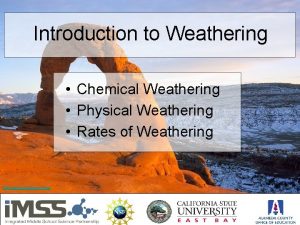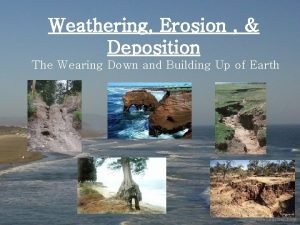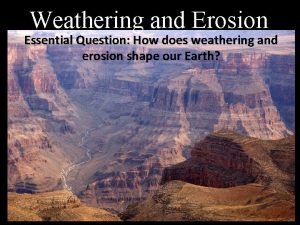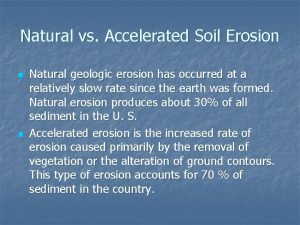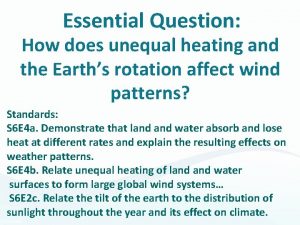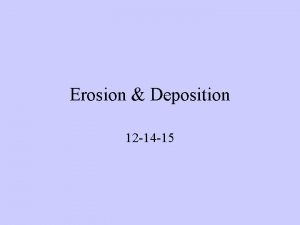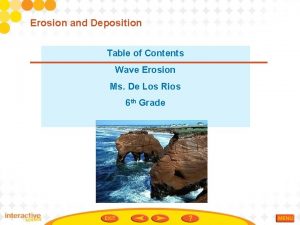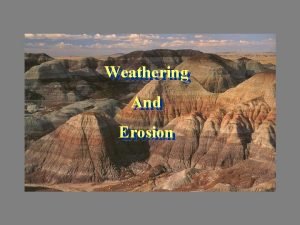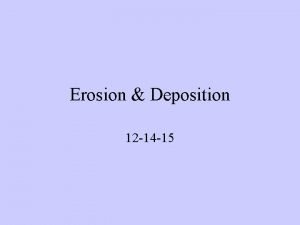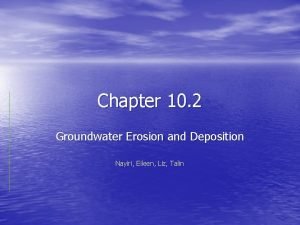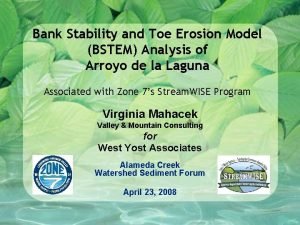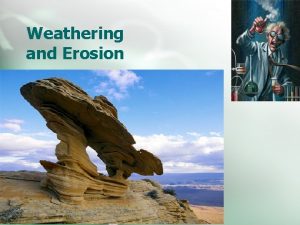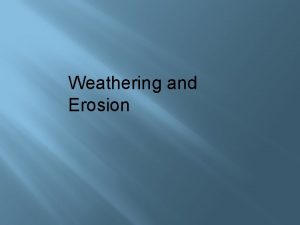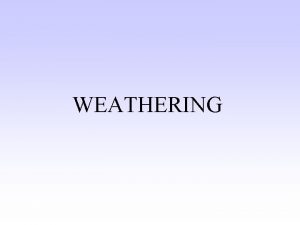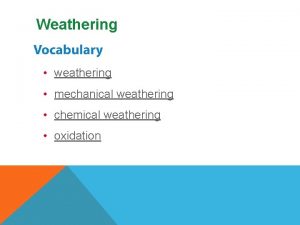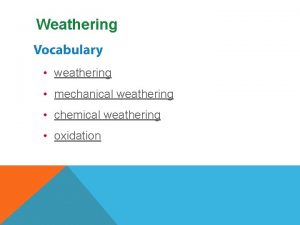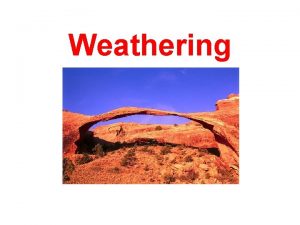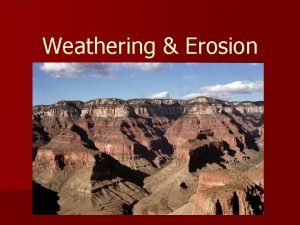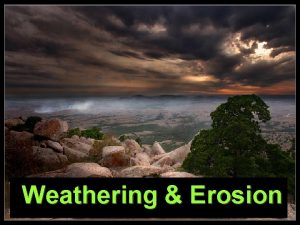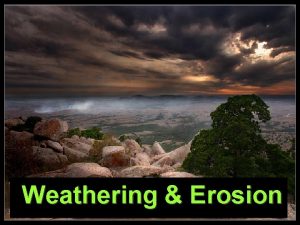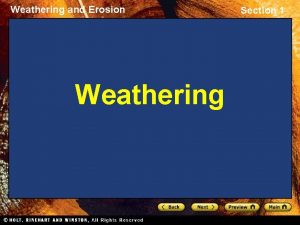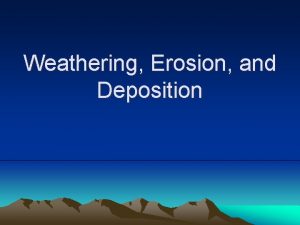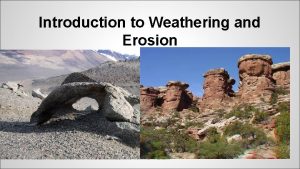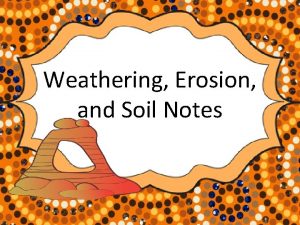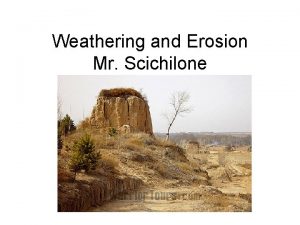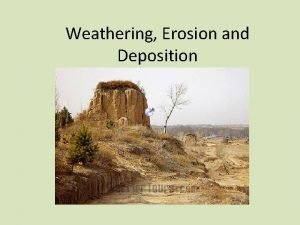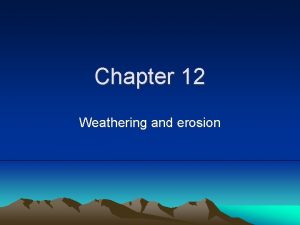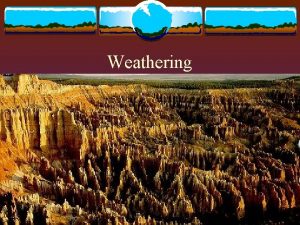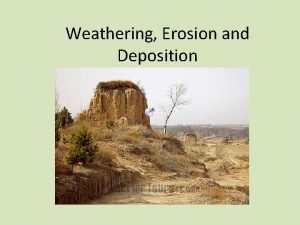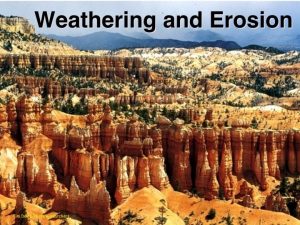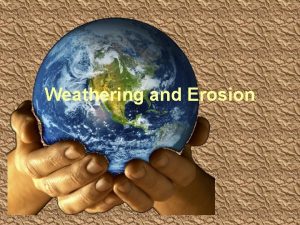Weathering And Erosion Weathering Erosion Standard S 6


























































- Slides: 58

Weathering And Erosion

Weathering & Erosion: Standard: S 6 E 5 Students will investigate the scientific view of how the earth's surface is formed.

Elements: • d. Describe processes that change rocks and the surface of the earth. • f. Explain the effects of physical processes (plate tectonics, erosion, deposition, volcanic eruption, gravity) on geological features including oceans (composition, currents, and tides).

Essential Question: • What are the characteristics of weathering, and how does weathering differ from erosion? • KEY QUESTIONS: – What is meant by weathering? – How many different kinds of weathering processes are there? – How are weathering and erosion different? – How are weathering and erosion related?

Weathering: • The slow wearing away or breaking down of objects that are exposed to Earth’s atmosphere and water.

Weathering breaks rock into smaller and smaller pieces, such as sand, silt, and clay. The terms sand, silt, and clay are used to describe specific sizes of sediments. Sediment then changes gradually into soil. The formation of soil depends upon the amount of weathering that occurs in a specific place.

Two kinds of weathering: Mechanical Weathering Chemical Weathering Both mechanical and chemical weathering work together to shape Earth’s surface.

Mechanical Weathering: • Objects are broken down into small pieces but their chemical makeup doesn’t change. • Example: Wearing away a piece of wood using sandpaper to smooth the wood. You wear away the wood, but it’s still wood.

Exfoliation fractures in granite on Stone Mountain, Georgia. http: //www. gly. uga. edu/railsback/Field. Images. html

Frost Action or ice wedging slowly breaks up this sedimentary rock into unusual shapes.

• Root wedging in a large boulder in northern Georgia, U. S. A http: //www. gly. uga. edu/railsback/Fi eld. Images. html

Ways rocks are mechanically weathered: • Animals: burrow by breaking apart sediment and move it to the surface. • Plants: roots can grow beneath a sidewalk, cracking the concrete and pushing it up. • Ice wedging: water enters cracks in rocks and freezes/expands. This pressure breaks the rocks apart.

Chemical Weathering: • Occurs when chemical reactions dissolve the minerals in rocks or change them into different minerals. • Example: – Leaving your bike outside and exposed to elements such as rain, metal parts on the bike will eventually rust. This is due to oxidation – when metallic materials are exposed to oxygen and water over prolonged periods of time.

Ways rocks are chemically weathered • Natural Acids: water mixes with carbon dioxide gas in the air or soil and forms a weak acid called carbonic acid. (this is the same weak acid that makes soft drinks fizzy when shaken) -- Carbonic acid reacts with minerals such as calcite. The reaction causes the calcite to dissolve. Carbonic acid has weathered much limestone in caves.

Other methods of chemical weathering: • Naturally occurring acids come in contact with other rocks. The mineral feldspar (found in granite & some types of sandstone) is broken down into a clay mineral called kaolinite. Clay is an end product of weathering. • Plant acids: some roots and decaying plants give off acids that can dissolve minerals in rocks. • Oxygen: (Oxidation) - occurs when metal is exposed to oxygen & water over prolonged periods of time and causes rust to occur.

1908 to 1969 Acid rain has eaten away this limestone statue. Acid Rain

Climates effect on weathering • Cold climates: – Mechanical weathering rapidly breaks down rocks through the process of ice wedging. Low temperatures slow the chemical weathering process. • Warm Moist Climates – Chemical weathering occurs more quickly in tropical areas. • Warm Dry Climates – Lack of moisture slows down chemical weathering.

Weathering & Rock Type • Rock type affects the rate of weathering in a particular climate. • Example: – Wet climates: marble weathers more rapidly than granite.

Weathering: • affects rocks, caves, mountains, and even buildings and streets. • Is an important part of the rock cycle. • Breaks down rocks. • Produces sediment that can form sedimentary rocks. • Begins the process of forming soil from rock and sediment.

Characteristics: Definition: Slow wearing away or breaking down of objects that are exposed to Earth’s atmosphere and water. Examples: Rocks show signs of decay: pitting, breaking, flaking, crumbling, swelling, surface crusts and discoloration. Weathering Non-Examples: Mechanical Weathering: Animals, plants, & ice wedging Chemical Weathering: Acids, oxidation. Mining Grinding Carving

Amazing Caves !!! • Formation of caves due to oxidation • Carlsbad Cavern National Park

Words To Know: • Mechanical Weathering: objects (rocks) are broken down into small pieces but their chemical makeup doesn’t change. • Chemical Weathering: Chemical reactions dissolve the minerals in rocks or change them into different minerals. • Ice wedging: where water enters cracks in rocks & freezes, expands, and causes rocks to crack. • Oxidation: when metallic materials are exposed to oxygen and water over prolonged periods of time.

Erosion There are many kinds of Erosion. Here a few: • Wave Action • Avalanche • Creep • Running Water • Glaciers • Rock Fall • Landslides • Slump • Mud Flow

EROSION: • A natural process of moving weathered rock and soil to another place. • Carves the Earth’s surface creating canyons, gorges, and even beaches. • Changes the landscape by wearing down mountains, filling in valleys, and making rivers appear and disappear.

Erosion: • Usually a slow and gradual process that occurs over thousands or millions of years. • Human activity such as farming, construction and mining can speed up erosion • Particles carried by wind and moving water rub against exposed objects. The rubbing wears away objects or breaks them into small parts

Five agents of erosion: • Gravity (constant pulling on all matter on Earth. • Running water (rivers and streams) • Wind • Glaciers • Waves

This is a picture of a landslide. A type of mass wasting.

In this picture the land has slumped into the road below.

This is a diagram of creep. The hillside slowly slips over many years from temperature or water.

This is a picture of an avalanche. It is similar to a landslide with ice and snow instead of rock.

This is a picture of a glacier which carves out a U-shaped valley where it flows dragging rocks and boulders along the way.

Dangers of Erosion • Soil particles moved during erosion are often washed and blown into our waterways and can cause the following problems: – it decreases the water clarity (less light for plants to photosynthesize) – fine sediments can suffocate fish and other water life – increased nutrients encourage undesirable plants and animals.

Erosion and sedimentation control in Georgia • The US EPA (United States Environmental Protection Agency) has listed soil erosion and sedimentation as one of the biggest threats to our nation's rivers, lakes, and ponds. Due to our land disturbing activities, the United States loses more than 2 billion tons of topsoil each year to erosion (USDA). http: //www. rivercenter. uga. edu/service/erosion. htm

Erosion is increased if land: • has little vegetation on it • is steep • is on the bank of a river or lake • is disturbed (farming, construction, etc) • has erosion prone geology (for example mudstone or pumice) • is under pressure from high stock density or machinery • is in an area of high and intensive rainfall.

Reducing the risk of Erosion • planting trees on hills and stream banks • fencing gullies and waterways to prevent stock access • removing wild goats and rabbits (they eat the vegetation) • keeping stock off steep pasture when it is wet • planting cover crops when land is left fallow • No-till farming methods • ripping wheel tracks in cultivated land where runoff and erosion along wheel tracks is a problem (Plant with the contour of the land) • retiring unproductive land • not cultivating steep land.

Erosion by Water: • water in all its forms causes erosion – Raindrops (especially in dry environments) create splash erosion that moves tiny particles of soil. – Water collecting on the surface of the soil collects as it moves towards tiny rivulets and streams and creates sheet erosion. – The faster water moves in streams the larger objects it can pick up and transport.

Streams erode their banks in three different ways • 1) the hydraulic action of the water itself moves the sediments • 2) water acts to corrode sediments by removing ions and dissolving them • 3) particles in the water strike bedrock and erode it.

In this picture the running water eroded the sides of this canyon and created the V-shaped valleys.

Waves cause erosion by four different methods: • Breaking – as the breaking waves hit the shoreline, their force knocks off pieces of existing rocks. • Forcing water into the cracks of the rocks on the shoreline • Abrasion- waves carry small rocks and sand that scrape other rocks • Chemical weathering (salt water breaks down the rocks)

Wave action is when waves hit the rocks and pieces of rock break off.

Factors that affect the rate of erosion at the shoreline include: • Size of the waves • Force of the waves • Type of the rock As erosion of the shore continues several features may result: Sea Cliffs, Terraces, Sea Stacks, and Sea Caves

Where does beach sand come from? • Streams and rivers deposit sediment from mountains into the ocean water. • Waves erode rocks at the shoreline. The color and texture of the sand depends on the type of rock that was eroded.

Erosion by Wind: • The most active agent of erosion with sand is wind. As the wind blows it picks up small particles of sand/sediment and blasts large rocks with the abrasive particles, cutting and shaping the rock. The ability for wind to erode larger rocks is controlled by: – – Size of particles Speed of wind Length of time wind blows Resistance of rocks

Wind Erosion • occurs almost always in deserts • Major cause of Dust Bowl of the 1930’s • physically removes the lighter, less dense soil particles such as organic matter, clays, and silts • removes the most fertile part of the soil and lowers soil productivity

• Wind erosion in the United States is most widespread on agricultural land in the Great Plains states • It is worse in arid and semiarid regions • Some soil from damaged land enters suspension and becomes part of the atmospheric dust load. Dust obscures visibility and pollutes the air and water, causes automobile accidents, fouls machinery, and imperils animal and human health. Wind erosion reduces the land's ability to produce crops.

These rocks have been blasted by wind and sand causing them to become rounded. WIND ABRASION

Deposition of Sediment: • Deposition is the process by which sediments (small particles of rock) are laid down in new locations. • Deposition builds new landforms. Usually water is responsible for deposition but landslides can be caused by earthquakes and volcanoes.

The Grand Canyon

Channels • A channel is a body of water that connects two larger bodies of water (like the English Channel). A channel is also a part of a river or harbor that is deep enough to let ships sail through. Created by slowing of flowing water & depositing of sediment. Satellite view of the English Channel http: //en. wikipedia. org/wiki/English_Channel

Definition: Characteristics: Affected by wind, water, ice, slope, gravity, waves, sediment size, and human activity. Natural moving of material from one place to another. In the United States almost 2 billion tons of Earth’s surface has been moved from one place to another. Logging Mining Farming Construction Examples: Grand Canyon Dust Bowl Channels EROSION Non-Examples: Adding Plants to an area. Weathering

Logging: • If a forest is “clear-cut” all of the trees in an area are cut down. Roots that had previously held soil in place die and decay. • Rain falls on the bare soil and washes away much of the topsoil, robbing the area of nutrients and minerals needed by plants to grow.

Mining • Land is stripped away. • Large pits are cut into the land. • Both strip mining and open-pit mining remove plants from an area. Again, plants are needed to “anchor” the soil so that it is not easily eroded.

Farming: Farmers tend to plow away topsoil with each crop. Droughts can strike farmland. When plants die due to a drought, the soil becomes exposed to forces of nature (water and wind) and is carried away.

Construction: • Building of roads, buildings, and communities removes natural barriers (plants) that help prevent erosion of soil. • Erosion speeds up and land becomes barren and ugly.

Important Words: 1. Runoff: Water that does not soak into the ground or evaporate but flows across Earth’s surface. 2. Abrasion: occurs when windblown sediments strike rocks and sediment, polishing and pitting their surfaces. 3. Deposition: dropping of sediments that occurs when an agent of erosion (such as gravity, a glacier, wind, or water) loses its energy and can no longer carry its load.

4. Mass movement: any type of erosion that happens as gravity moves materials down slope. (see next slide) 5. Slump: when a mass of material slips down along a curved surface. 6. Creep: occurs when sediments slowly shift their positions downhill. Common in areas of freezing and thawing. 7. Mudflows: thick pasty mixture (made when heavy rains add water with loose sediments) is pulled downward by gravity. 8. Channels: groove created when water moving down the same path slows and deposits sediment.

Mass Movements • Landslides, mudslides, slump and creep landslide clip. mpeg

Ticket-Out-The-Door Monday 11 -26 -07 • Explain how mechanical weathering and chemical weathering are different from each other.
 Rill erosion
Rill erosion Trans pecos erosion
Trans pecos erosion The three types of weathering
The three types of weathering Rain washing away soil from a hillside
Rain washing away soil from a hillside Bill nye weathering and erosion
Bill nye weathering and erosion Weathering and erosion video
Weathering and erosion video Weathering and erosion difference youtube video
Weathering and erosion difference youtube video Weathering and erosion questions
Weathering and erosion questions Piney woods weathering erosion and deposition
Piney woods weathering erosion and deposition Deposition in south texas plains
Deposition in south texas plains Get5gets.com
Get5gets.com Physical erosion
Physical erosion Weathering erosion and deposition
Weathering erosion and deposition Weathering and erosion
Weathering and erosion Weathering and erosion study guide
Weathering and erosion study guide Chapter 14 weathering and erosion review answers
Chapter 14 weathering and erosion review answers What happens when weathering and erosion work together?
What happens when weathering and erosion work together? Weathering webquest
Weathering webquest Chapter 7 weathering erosion and soil
Chapter 7 weathering erosion and soil Soils in ____ contain little organic material and are thin.
Soils in ____ contain little organic material and are thin. Distinguish between weathering and erosion
Distinguish between weathering and erosion Weathering vs erosion
Weathering vs erosion Breaking down of rocks
Breaking down of rocks Weathering and soil erosion
Weathering and soil erosion Weathering erosion and deposition
Weathering erosion and deposition Weathering and erosion
Weathering and erosion Agents of weathering
Agents of weathering Weathering and erosion virtual field trip
Weathering and erosion virtual field trip Weathering and erosion
Weathering and erosion Weathering erosion and deposition in texas ecoregions
Weathering erosion and deposition in texas ecoregions Erosion and weathering
Erosion and weathering Types of chemical weathering
Types of chemical weathering Define the term weathering
Define the term weathering Agents of erosion
Agents of erosion Weathering vs erosion
Weathering vs erosion Mechanical and chemical weathering venn diagram
Mechanical and chemical weathering venn diagram Weathering erosion
Weathering erosion Weathering vs erosion
Weathering vs erosion Weathering vs erosion
Weathering vs erosion Two types of weathering
Two types of weathering Introduction to weathering
Introduction to weathering Standard error or standard deviation
Standard error or standard deviation Standard language in sociolinguistics
Standard language in sociolinguistics Meaning of standard costing in cost accounting
Meaning of standard costing in cost accounting Bahagian pembangunan kurikulum dskp kssm
Bahagian pembangunan kurikulum dskp kssm Compare and contrast mechanical and chemical weathering
Compare and contrast mechanical and chemical weathering Mechanical and chemical weathering venn diagram
Mechanical and chemical weathering venn diagram Glaciers cause erosion by abrasion and
Glaciers cause erosion by abrasion and Walther penck
Walther penck Differentiate between geological and accelerated erosion
Differentiate between geological and accelerated erosion Unequal heating
Unequal heating Esker
Esker Table
Table A tiny groove in soil made by flowing water
A tiny groove in soil made by flowing water Dilation and erosion examples
Dilation and erosion examples Agents of erosion
Agents of erosion Diagram of erosion and deposition
Diagram of erosion and deposition Groundwater erosion and deposition
Groundwater erosion and deposition Bank stability and toe erosion model
Bank stability and toe erosion model


